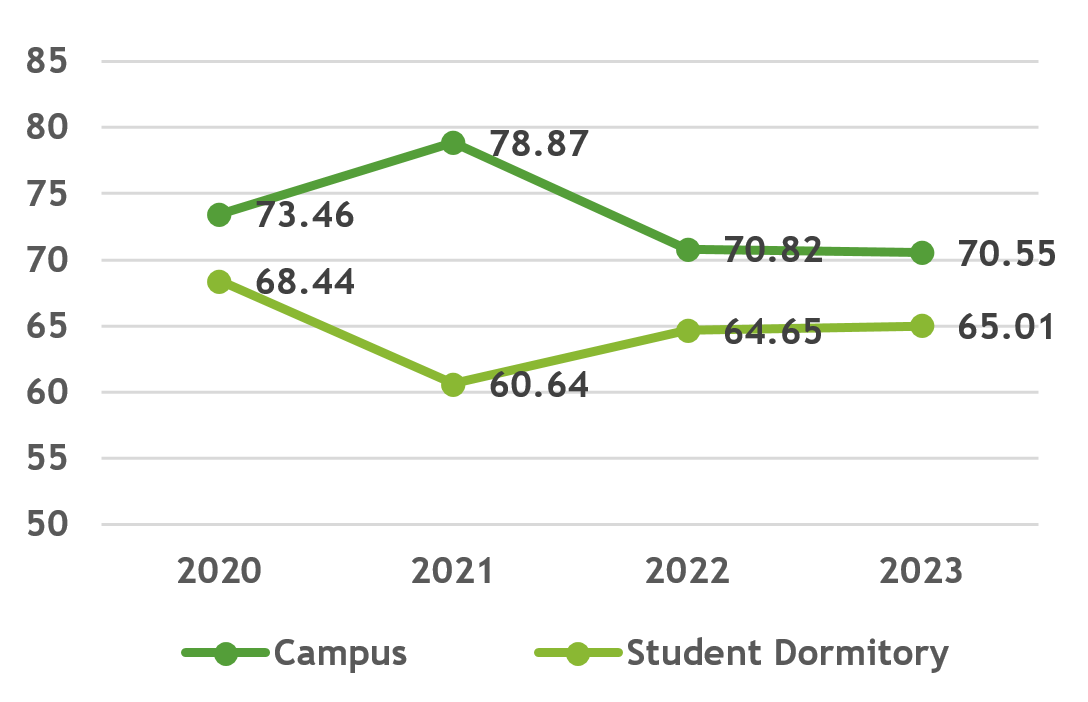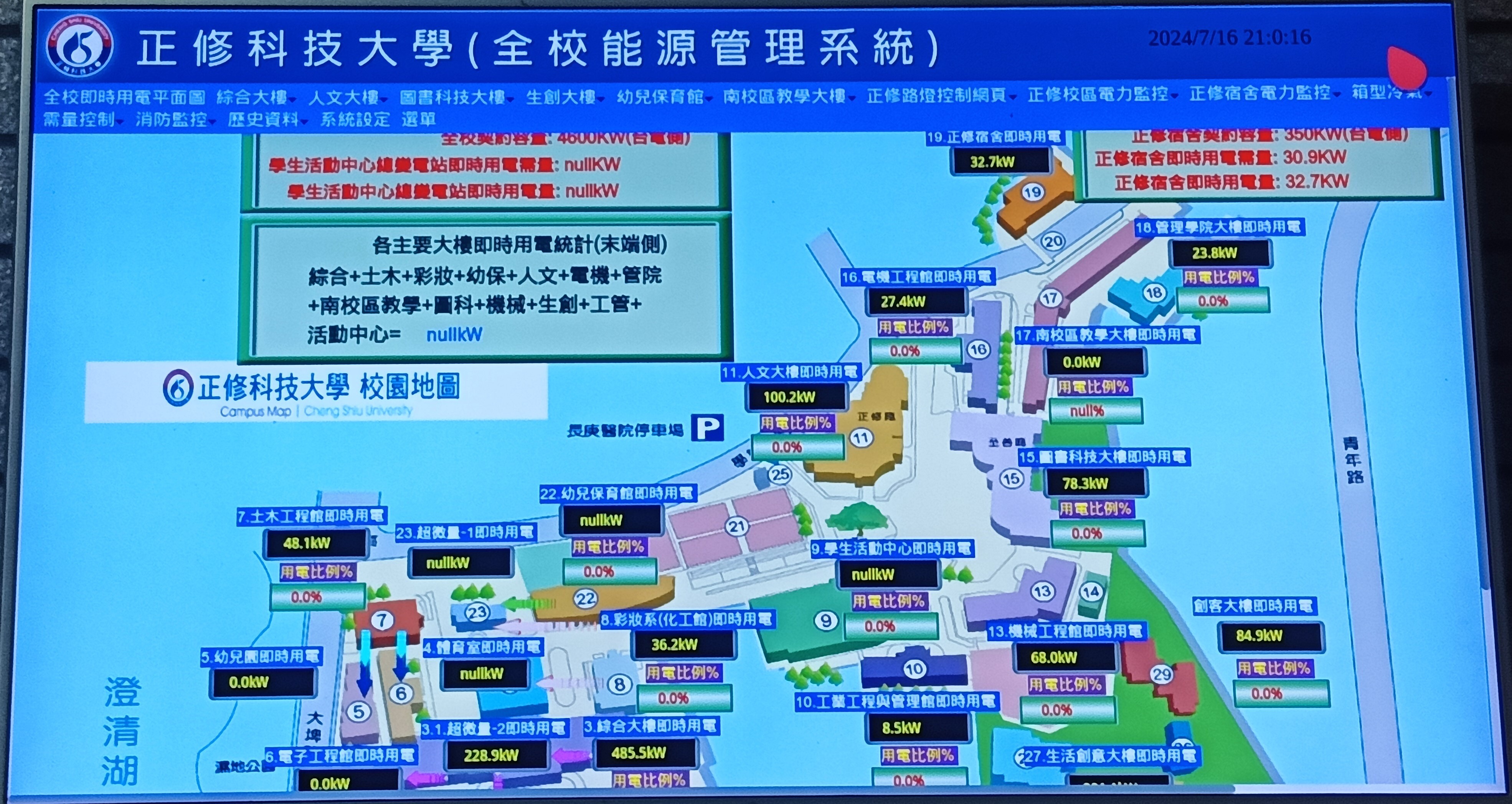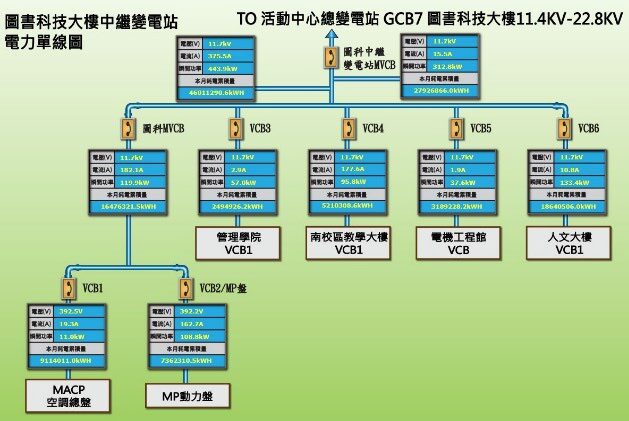Energy Resource Management
Energy Management
The Administrative Office of our university is one of the key organizations promoting the low-carbon campus initiative, committed to creating energy-efficient, resource-saving, healthy, and comfortable campus buildings and an ecologically friendly environment. In 2023, the total energy consumption across the entire campus was 57,142.484 GJ, with externally sourced electricity amounting to 14,484.624 thousand kWh. The data shows a slight increase of 0.97%, attributable to the establishment of a precision machinery training facility and the commissioning of new teaching equipment in 2023, which led to a rise in electricity demand.
|
Item / Year |
Unit |
2022 |
2023 |
|
Purchased electricity |
mWh |
14,345.84 |
14,484.624 |
|
GJ |
51,645.02 |
52,144.646 |
|
|
Gasoline |
L |
34,106.22 |
27,258.030 |
|
GJ |
1,113.60 |
899.996 |
|
|
Diesel |
公升 |
73,122.53 |
83,553.380 |
|
GJ |
2,571.16 |
2,937.937 |
|
|
Natural gas |
m3 |
25,664 |
20,778.800 |
|
GJ |
966.87 |
782.821 |
|
|
Liquefied petroleum gas (LPG) |
公升 |
14,078.59 |
13,576.824 |
|
GJ |
391.02 |
377.084 |
|
|
Total energy consumption |
GJ |
56,687.67 |
57,142.484 |
|
Floor area |
m2 |
212,732 |
215,168 |
|
Energy intensity |
kWh/m2 |
67.44 |
67.318 |
Note: Energy Content: The energy content of externally sourced electricity is 3,600 GJ per million kWh; using the conversion factors from the Environmental Protection Administration's "Greenhouse Gas Emission Factor Management Table Version 6.0.4," the conversion factors for vehicle gasoline, diesel, natural gas, and liquefied petroleum gas are 7,800 kcal/L, 8,400 kcal/L, 9,000 kcal/m³, and 6,635 kcal/L, respectively. According to the "Energy Product Unit Calorific Value Table" from the Bureau of Energy, Ministry of Economic Affairs, liquefied petroleum gas (general) has a conversion factor of 1 kg = 1.818 L; calculations are based on the joule conversion factor (4.186 kJ/kcal); method for calculating energy intensity: the amount of externally sourced electricity used by the university divided by the floor area.
Energy Conservation Strategies, Measures, and Performance
•Establish Key Points for Campus-wide Energy Conservation Management
• Optimize Energy Management System
•Install Smart Meters in All Campus Buildings
•Implement Energy-saving Controls for Campus-wide Air Conditioning
•Intelligent Management of Campus Lighting
•Improve Water Conservation Facilities on Campus
To implement the energy conservation policies of the government and regulatory authorities, our university has set short-, medium-, and long-term energy-saving strategies and carbon reduction targets. The university actively promotes various energy-saving measures, environmental education initiatives, and prioritizes the procurement of energy-efficient products to improve energy use efficiency.
Trend Chart of Externally Sourced Electricity (Unit: mWh)
 |
Energy Conservation Targets
|
•Short-term
|
•Replace the chiller in the Humanities Building and install variable frequency split air conditioners with energy-saving labels, along with air conditioning control devices.
•Install smart card readers to reduce energy consumption.
•Monthly cleaning of air conditioner filters can reduce electricity consumption by 10%.
|
|
•Mid-term
|
•Replace the chiller in the Library and Technology Building with variable frequency split air conditioners and implement card-operated air conditioning power control.
•Significantly reduce the risk of equipment damage from lightning strikes and eliminate unnecessary energy usage.
•Complete the modernization of the elevators in the Library and Technology Building, with an estimated annual savings of 15 metric tons of carbon emissions (CO2e).
|
|
•Long-term
|
•Phased replacement of air conditioning units and installation of card-operated air conditioning power control across the entire campus.
•Replace the chiller in the Creative Living Building and install variable frequency split air conditioners with energy-saving labels, along with air conditioning control devices.
•Increase renewable energy utilization to 10%.
|
Greenhouse Gas Emission Management
To effectively manage greenhouse gas emissions, our university adopted ISO 14064-1:2018 in 2022 to conduct greenhouse gas accounting. The university plans to perform annual inventories and publish reports regularly. In 2023, total greenhouse gas emissions reached 7,589.691 metric tons of CO2e, with Scope 2 emissions as the primary source, contributing approximately 94.28% of the total emissions.
|
▲ Campus-wide Energy Management System |
▲ Single-line Diagram of the Substation |
Energy-saving Measures Implemented in 2023
▸ To reduce power waste, air conditioning and electricity were provided to general and specialized classrooms according to the class schedule.
▸ To prevent unnecessary energy waste, smart meters were installed in department offices and faculty research rooms in the Library and Technology Building for effective energy management.
▸ In 2023, the traditional central Hitachi chiller in the Library and Technology Building was replaced with 151 energy-efficient variable frequency air conditioners.
▸ An energy management system was implemented across the campus and dormitories, using automated time-controlled systems for electrical facilities to manage energy effectively with scheduled power on/off times.
▸ Three new elevators were installed in the Library and Technology Building, equipped with energy recovery systems to recycle and reuse energy, reducing elevator power consumption.
▸ A new ultra-precision teaching building for the Mechanical Engineering Department was constructed, starting in September 2022 and completed in July 2023, featuring a solar photovoltaic system and a rainwater harvesting system.
|
Item |
Unit |
2022 |
2023 |
|
Category 1: Direct GHG emissions |
Metric tons CO2e |
434.69 |
434.287 |
|
Category 2: Indirect GHG emissions from imported energy |
Metric tons CO2e |
7,101.19 |
7,155.404 |
|
Category 1 + Category 2 |
Metric tons CO2e |
7,535.88 |
7,589.691 |
|
Floor area |
m2 |
212,732 |
215,168 |
|
GHG emission intensity |
Metric tons CO2e/m2 |
0.035 |
0.0353 |
Sites for Renewable Energy Installations
In response to the global trend and demand for energy conservation and carbon reduction, local governments are promoting the installation of renewable energy systems by large electricity users through incentives or regulations. Our university has rented the rooftops of various buildings to external companies for the installation of solar photovoltaic systems. These include eight buildings, such as the Library and Technology Building, the College of Management Building, and the Student Activity Center. In 2023, the total installed capacity of the solar photovoltaic systems was 757.84 KW.

Renewable Energy Usage Ratio
|
|
Note: The renewable energy usage ratio is calculated as (renewable energy consumption / total electricity consumption), including both on-site consumption and electricity sold back to Taipower.
Water Resource Management
The primary uses of water resources include domestic water, campus plant irrigation, and laboratory water, with domestic water being the largest use. The water quality from the source is all freshwater (≤1,000 mg/L total dissolved solids). According to the Aqueduct water risk assessment tool provided by the World Resources Institute (WRI), our university is located in a moderate to low water risk region (yellow area), as illustrated in the accompanying image.

Water Conservation Strategies, Measures, and Performance
•Adjust water-saving valves to reduce faucet flow rates. Dispatch personnel to inspect leak-prone areas and promptly repair any faulty leaking equipment.
•When replacing faulty equipment, prioritize water-saving certified equipment.
•Install rainwater storage facilities in new buildings to collect rainwater and reuse daily wastewater for toilet flushing or irrigation.
•Plan the installation of water-saving devices in existing buildings and new construction projects to achieve water reduction goals.
•Encourage turning off taps and prompt reporting of leaks through posters, slogans, and various communication channels.
Our university's water conservation goal is to gradually upgrade water-saving equipment and enhance water conservation promotion. New construction projects are designed to integrate water-saving measures to achieve the objectives of water preservation and sustainable use. In 2023, the total water withdrawal for the entire campus (including student dormitories) was 135.56 million liters, a reduction of 4.48% compared to 2020. Additionally, the per capita water usage at our university was 21.5 L/day, significantly lower than the 70 L/day average at national technical and vocational institutions.
Municipal Water Withdrawal (Unit: million liters)


